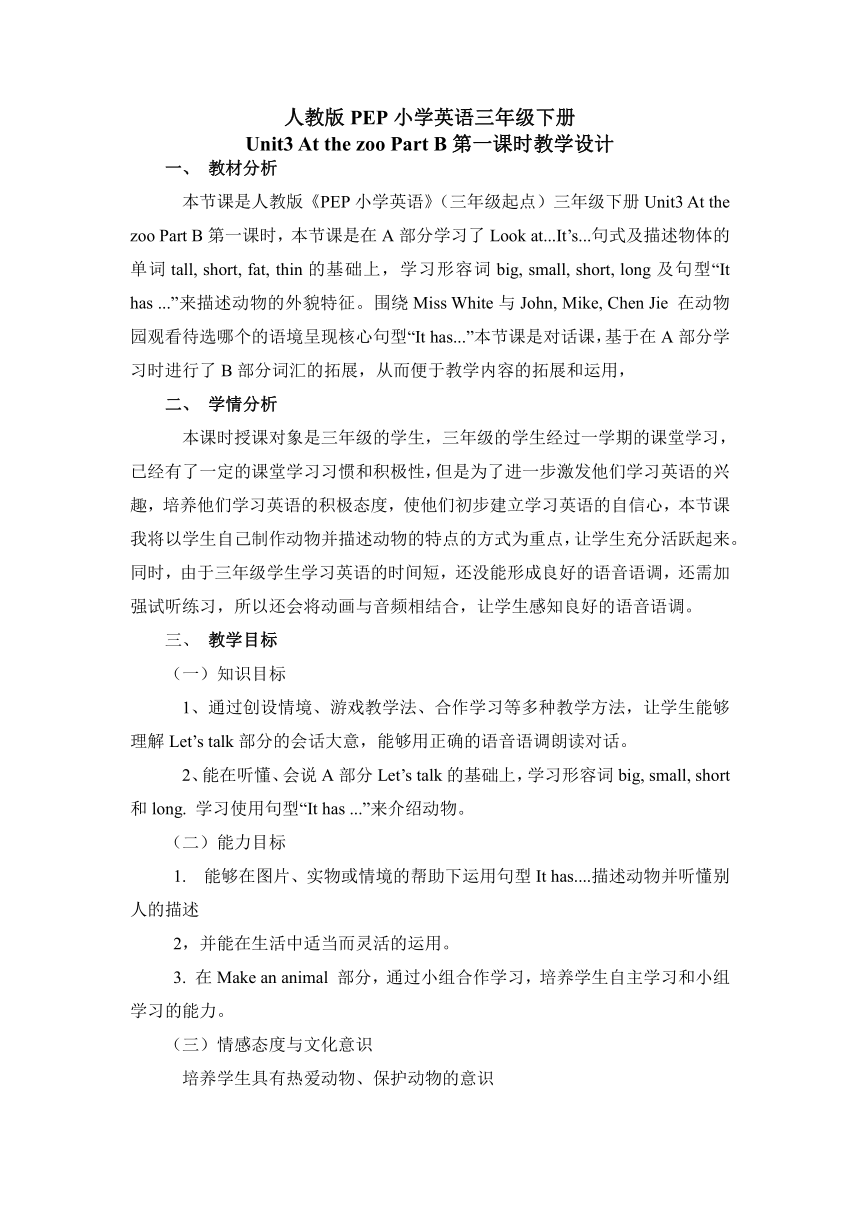Unit 3 At the zoo Part B Let's talk 教案
文档属性
| 名称 | Unit 3 At the zoo Part B Let's talk 教案 |

|
|
| 格式 | docx | ||
| 文件大小 | 17.9KB | ||
| 资源类型 | 教案 | ||
| 版本资源 | 人教版(PEP) | ||
| 科目 | 英语 | ||
| 更新时间 | 2022-02-03 18:51:06 | ||
图片预览


文档简介
人教版PEP小学英语三年级下册
Unit3 At the zoo Part B第一课时教学设计
教材分析
本节课是人教版《PEP小学英语》(三年级起点)三年级下册Unit3 At the zoo Part B第一课时,本节课是在A部分学习了Look at...It’s...句式及描述物体的单词tall, short, fat, thin的基础上,学习形容词big, small, short, long及句型“It has ...”来描述动物的外貌特征。围绕Miss White与John, Mike, Chen Jie 在动物园观看待选哪个的语境呈现核心句型“It has...”本节课是对话课,基于在A部分学习时进行了B部分词汇的拓展,从而便于教学内容的拓展和运用,
学情分析
本课时授课对象是三年级的学生,三年级的学生经过一学期的课堂学习,已经有了一定的课堂学习习惯和积极性,但是为了进一步激发他们学习英语的兴趣,培养他们学习英语的积极态度,使他们初步建立学习英语的自信心,本节课我将以学生自己制作动物并描述动物的特点的方式为重点,让学生充分活跃起来。同时,由于三年级学生学习英语的时间短,还没能形成良好的语音语调,还需加强试听练习,所以还会将动画与音频相结合,让学生感知良好的语音语调。
教学目标
(一)知识目标
1、通过创设情境、游戏教学法、合作学习等多种教学方法,让学生能够理解Let’s talk部分的会话大意,能够用正确的语音语调朗读对话。
2、能在听懂、会说A部分Let’s talk的基础上,学习形容词big, small, short和long. 学习使用句型“It has ...”来介绍动物。
能力目标
1. 能够在图片、实物或情境的帮助下运用句型It has....描述动物并听懂别人的描述
2,并能在生活中适当而灵活的运用。
3. 在Make an animal 部分,通过小组合作学习,培养学生自主学习和小组学习的能力。
情感态度与文化意识
培养学生具有热爱动物、保护动物的意识
教学重点
1、听、说、认读单词big, small, long和short
2、能够熟练运用句型“It has ...”介绍动物。
五、教学难点
学生能区分“It has a +形容词+单数身体部位”和“It has +形容词+复数身体部位”的句型。
教学用具
多媒体设备,课件,图片,人物头饰等
教学过程
Step1. Warming up
1. 利用多媒体播放A部分已学Let’s do, 师生同做,学生视听并全身活动。
(设计意图: 活跃课堂气氛,创设良好的学习氛围并巩固旧知)
Be fat. Be fat. Be fat, fat, fat!
Be thin. Be thin. Be thin, thin, thin.
Be tall. Be tall. Be tall, tall, tall.
Be short. Be short. Be short, short, short.
2. Free talk (Greeting with each other)
(设计意图:让学生感知英语氛围,加强口语训练,同时逐步进入英语学习环境。)
T: Good morning, boys and girls.
Ss:Good morning, Miss Wu.
T: How are you
Ss: I’m fine, thank you. And you
…
Step2. Revision
1. Braining storm
利用PPT播放动物园中不同动物的图片,此部分的动物都是学生在三年级上册已学过内容,通过“头脑风暴”的形式,唤醒已学知识在学生头脑中的印象。(此部分以竞赛方式进行,每答对一个为本小组赢得一星。)
(Yesterday you did a good job, so today Miss Wu will lead you to visit a zoo. Do you like animals OK, Let’s see together. What can you see in the zoo )
2. Let’s review(复习上节课旧知,初步了解本课主题)
PPT播放上节课已学知识,用一对高矮不同的长劲鹿和一对胖瘦不同的猴子进行比较回忆,再次回顾单词tall, short, fat, thin以及句型结构It’s so…
(Last class, we learn a new animal, do you remember Let’s have a look.)
Step3 Presentation
Teach the new dialogue and get the students to know.(自主学习,小组交流合作,交互语言学习。)
1. What’s missing 回顾这么多动物之后,让学生再想想我们遗忘了哪个动物,思考之后,PPT呈现大象的图片从而引出本课的主题。请学生观察画面上的大象,问:
T:What’s this Look at the elephant. Wow! It’s so big. Look at its nose. It’s long.
配合手势和肢体语言,让学生充分理解单词long,并板书。同时引导学生说出:
Ss; it’s so long.
T: Yes. It has a long nose. Look at its tail. Is it long, too
Ss: No, it isn’t. it’s short..
T:Yes. It has a long nose and a short tail.
(板书并带读短语a long nose 和a short tail.)
T: Look at its eyes. Are they small or big
Ss:Small!
T:Yes. It has small eyes. Look at its ears. Are they small, too
Ss: No, they are so big.
T: Yes, it has small eyes and big ears.
(板书并带读短语 small eyes 和big ears.)
2. 通过手势和物体的对比,让学生充分理解long和short以及big和small。
3. Let’s talk
(1)引导学生看B部分Let’s talk的图,猜测人物的对话内容。
(2)播放对话录音三遍,引导学生理解课文对话依次回答问题
What does Chen Jie say about the elephant
What does John say about the elephant
What does mike say about the elephant
(3) 学生打开课本听录音,解释并理解Come here, children. 的意思。
(4) 学生跟读录音朗读对话2遍,老师教读1遍,然后戴头饰分角色表演。
Step4 Practice
Let’s order the sentences.
将本课句型顺序打乱,要求学生快速按正确的顺序将其排列。
1. long, is, so, it.
It is so long.
2. has, it, short, tail, a.
It has a short tail.
3. ears, has, it, big.
It has big ears.
Step5 Consolidation
Let’ make an animal
1. 教师示范用已打乱的动物身体部位组合完整的动物图。
2. Work in groups. 学生以小组为单位,合作完成动物的组合,并向全班展示本小组组合的动物,利用所学内容描述动物。本部分以小组竞赛的方式进行,小组第一展示得三星,第二展示得两星,第三展示得一星。
Step6 Summing up
Evaluate the performance of the students in the class.
由本节课的活动总结学生的表现,主要通过每组的得分情况予以评价。
Step7 Homework
1. Do the Chang jiang exercise on page31
2. Talk about the animals with your friend in English.
Step8 The blackboard design
Unit3 At the zoo
It has a long nose.
It has a short tail.
It has big ears.
It has small eyes.
Unit3 At the zoo Part B第一课时教学设计
教材分析
本节课是人教版《PEP小学英语》(三年级起点)三年级下册Unit3 At the zoo Part B第一课时,本节课是在A部分学习了Look at...It’s...句式及描述物体的单词tall, short, fat, thin的基础上,学习形容词big, small, short, long及句型“It has ...”来描述动物的外貌特征。围绕Miss White与John, Mike, Chen Jie 在动物园观看待选哪个的语境呈现核心句型“It has...”本节课是对话课,基于在A部分学习时进行了B部分词汇的拓展,从而便于教学内容的拓展和运用,
学情分析
本课时授课对象是三年级的学生,三年级的学生经过一学期的课堂学习,已经有了一定的课堂学习习惯和积极性,但是为了进一步激发他们学习英语的兴趣,培养他们学习英语的积极态度,使他们初步建立学习英语的自信心,本节课我将以学生自己制作动物并描述动物的特点的方式为重点,让学生充分活跃起来。同时,由于三年级学生学习英语的时间短,还没能形成良好的语音语调,还需加强试听练习,所以还会将动画与音频相结合,让学生感知良好的语音语调。
教学目标
(一)知识目标
1、通过创设情境、游戏教学法、合作学习等多种教学方法,让学生能够理解Let’s talk部分的会话大意,能够用正确的语音语调朗读对话。
2、能在听懂、会说A部分Let’s talk的基础上,学习形容词big, small, short和long. 学习使用句型“It has ...”来介绍动物。
能力目标
1. 能够在图片、实物或情境的帮助下运用句型It has....描述动物并听懂别人的描述
2,并能在生活中适当而灵活的运用。
3. 在Make an animal 部分,通过小组合作学习,培养学生自主学习和小组学习的能力。
情感态度与文化意识
培养学生具有热爱动物、保护动物的意识
教学重点
1、听、说、认读单词big, small, long和short
2、能够熟练运用句型“It has ...”介绍动物。
五、教学难点
学生能区分“It has a +形容词+单数身体部位”和“It has +形容词+复数身体部位”的句型。
教学用具
多媒体设备,课件,图片,人物头饰等
教学过程
Step1. Warming up
1. 利用多媒体播放A部分已学Let’s do, 师生同做,学生视听并全身活动。
(设计意图: 活跃课堂气氛,创设良好的学习氛围并巩固旧知)
Be fat. Be fat. Be fat, fat, fat!
Be thin. Be thin. Be thin, thin, thin.
Be tall. Be tall. Be tall, tall, tall.
Be short. Be short. Be short, short, short.
2. Free talk (Greeting with each other)
(设计意图:让学生感知英语氛围,加强口语训练,同时逐步进入英语学习环境。)
T: Good morning, boys and girls.
Ss:Good morning, Miss Wu.
T: How are you
Ss: I’m fine, thank you. And you
…
Step2. Revision
1. Braining storm
利用PPT播放动物园中不同动物的图片,此部分的动物都是学生在三年级上册已学过内容,通过“头脑风暴”的形式,唤醒已学知识在学生头脑中的印象。(此部分以竞赛方式进行,每答对一个为本小组赢得一星。)
(Yesterday you did a good job, so today Miss Wu will lead you to visit a zoo. Do you like animals OK, Let’s see together. What can you see in the zoo )
2. Let’s review(复习上节课旧知,初步了解本课主题)
PPT播放上节课已学知识,用一对高矮不同的长劲鹿和一对胖瘦不同的猴子进行比较回忆,再次回顾单词tall, short, fat, thin以及句型结构It’s so…
(Last class, we learn a new animal, do you remember Let’s have a look.)
Step3 Presentation
Teach the new dialogue and get the students to know.(自主学习,小组交流合作,交互语言学习。)
1. What’s missing 回顾这么多动物之后,让学生再想想我们遗忘了哪个动物,思考之后,PPT呈现大象的图片从而引出本课的主题。请学生观察画面上的大象,问:
T:What’s this Look at the elephant. Wow! It’s so big. Look at its nose. It’s long.
配合手势和肢体语言,让学生充分理解单词long,并板书。同时引导学生说出:
Ss; it’s so long.
T: Yes. It has a long nose. Look at its tail. Is it long, too
Ss: No, it isn’t. it’s short..
T:Yes. It has a long nose and a short tail.
(板书并带读短语a long nose 和a short tail.)
T: Look at its eyes. Are they small or big
Ss:Small!
T:Yes. It has small eyes. Look at its ears. Are they small, too
Ss: No, they are so big.
T: Yes, it has small eyes and big ears.
(板书并带读短语 small eyes 和big ears.)
2. 通过手势和物体的对比,让学生充分理解long和short以及big和small。
3. Let’s talk
(1)引导学生看B部分Let’s talk的图,猜测人物的对话内容。
(2)播放对话录音三遍,引导学生理解课文对话依次回答问题
What does Chen Jie say about the elephant
What does John say about the elephant
What does mike say about the elephant
(3) 学生打开课本听录音,解释并理解Come here, children. 的意思。
(4) 学生跟读录音朗读对话2遍,老师教读1遍,然后戴头饰分角色表演。
Step4 Practice
Let’s order the sentences.
将本课句型顺序打乱,要求学生快速按正确的顺序将其排列。
1. long, is, so, it.
It is so long.
2. has, it, short, tail, a.
It has a short tail.
3. ears, has, it, big.
It has big ears.
Step5 Consolidation
Let’ make an animal
1. 教师示范用已打乱的动物身体部位组合完整的动物图。
2. Work in groups. 学生以小组为单位,合作完成动物的组合,并向全班展示本小组组合的动物,利用所学内容描述动物。本部分以小组竞赛的方式进行,小组第一展示得三星,第二展示得两星,第三展示得一星。
Step6 Summing up
Evaluate the performance of the students in the class.
由本节课的活动总结学生的表现,主要通过每组的得分情况予以评价。
Step7 Homework
1. Do the Chang jiang exercise on page31
2. Talk about the animals with your friend in English.
Step8 The blackboard design
Unit3 At the zoo
It has a long nose.
It has a short tail.
It has big ears.
It has small eyes.
